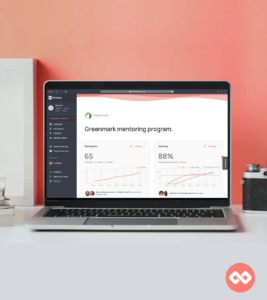Managing mentoring programs is typically a job given to someone in the Human Resources or People & Culture department. However, that’s not necessarily the case for all programs. Some of the most successful programs, especially in smaller organizations, are run by team leaders who might not have had any HR background at all.
If you’re a team leader, first of all, congratulations on making this investment in your team’s development! And secondly, we completely understand that it can be daunting to step out into what seems like a completely different field here. But there’s no need to worry! Trust us, if you’ve managed any project before, you already have the skills to run a mentoring program well. All you have to do is transfer those awesome project management skills to this particular project.
Let’s get to it.

Using the 5 Project Management Phases to Manage Your Mentoring Program
1. Project Initiation
Focus on making sure the program is fit for purpose and aligned with larger team goals. Manage expectations with stakeholders and seek leadership buy-in for the program.
For smaller teams that need little leadership approval, this can be a breeze, however, it can be more involved for bigger programs. The important thing is to have a clear goal for your program from the onset. Write them down and make plans on how to measure whether you’re achieving them or not. If you’re looking at a pilot program and unsure about what metrics to use, it might be helpful to come up with a few questions that you want this pilot to answer. (e.g. Will my team find this valuable? Will more than 50% of those invited actually sign up?)
Key activity: Leadership buy-in and setting clear goals
2. Project Planning
Scope out the work needed to run the program and start preparing for it to go live. If you have a team to run the program – great! Start delegating and splitting up duties. If not, don’t worry! Look around for tools you can use. While you could technically use spreadsheets and emails etc., mentoring software [link] such as Mentorloop is a great tool that helps you with all the admin tasks, monitoring your team’s progress, and seeing if your participants are finding value in the program.
Not sure what’s involved in the role of a program coordinator? We’ve got you.
Key activity: Resourcing and selecting tools
3. Project Execution
This stage is the time to put your plans into action. Here are some of the most important to-dos during this phase:
Decide on Your Matching Criteria and Matching Type
What are you basing matching on? Departments? Areas of specialty? Geography?
How are you pairing them up? Will you be letting them find their own mentoring partners and ask to connect or will you be deciding on who gets paired up? Do you want a matching algorithm to help you remove unconscious bias and result in better matching?
Curate Some Helpful Content
Some of your participants might not know what to do at the start so it would be helpful to give them guides. If you’re using Mentorloop, we surface helpful content at key moments in your participants’ mentoring journey. We also have a huge collection of resources for everything mentoring you can take advantage of!
You can start with our First Meeting Checklists for mentors and mentees, or any of these eBooks and resources:



Start Promoting your Program
Let your team know this is happening! Take advantage of assets available to you and make it easy for potential participants to find information about the program. If you need a bit of guidance, we’ve got a beginner’s guide here. And if you really want to get into the nitty-gritty, you can download our free guide here.

Launch Your Program
You can make your launch a big deal or low-key – whatever works for you!
Whichever way you choose to launch, we’ve got a guide that can help you out:

4. Project Monitoring and Control
This is the phase where you record data and measure progress. It’s important to note that this needs to be done while your program is still running, not at the end when you no longer have time to refocus and adjust. Don’t forget to check in with your participants (Mentorloop allows you to do this easily via live Sentiments). Use the information you get from these check-ins to adjust, send some encouragement or helpful content, or rematch mentoring partners.
Key Activity: Data Monitoring and Participant Check-ins
5. Project Closure
When your program or cohort comes to a close, it’s time to do a bit of a retrospective.
What went right? What went wrong? What changes could be made? Could this be scaled? What do your metrics look like? What are the answers to your questions at the beginning of this project?
If you think this is something that you should continue, make notes on the adjustments that should be made. And if you think this could be a great proof of concept for a larger program within your organisation, why not send it to other team leaders, or better yet, your People & Culture or Human resources officers?
It would also be good to think about a turnover document of sorts if you are handing this program over to someone else.
Key Activity: Documentation and turnover
So if you’re running a program for the first time as a non-HR leader, there’s no reason to think you couldn’t do this well. Simply adjust those already sharp project management skills and tweak them a little bit to fit the task at hand.
If you’re ready to get started, we’ve designed a toolkit with everything you’ll need to build a fantastic mentoring program from day one!





